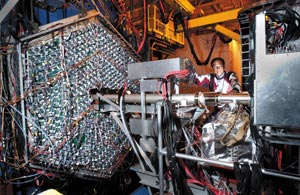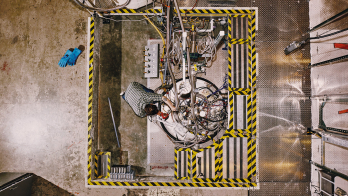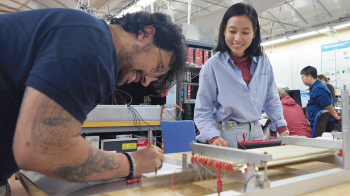
A detector built by an Indian team has begun running this year in the STAR experiment at the Relativistic Heavy Ion Collider at the Brookhaven National Laboratory. The Photon Multiplicity Detector (PMD) has been provided by a collaboration led by a group from the Variable Energy Cyclotron Centre in Kolkata, with colleagues from the Institute of Physics in Bhubaneswar and university groups from Chandigarh, Jaipur and Jammu.
The PMD is a preshower detector designed to study photon production of high particle densities in the forward region in relativistic heavy-ion collisions. This is an environment where calorimeters cannot be used due to the large overlap between particle showers. By measuring the spatial distribution of photons in phase space in common with charged particle detection, the PMD allows the study of event shapes and fluctuations in photon multiplicity and the charged to neutral ratio, thus throwing light on the deconfinement phase transition and chiral symmetry restoration. A PMD using plastic scintillators as the sensitive medium formed part of the WA93 and WA98 experiments at the CERN Super Proton Synchrotron (CERN Courier September 1991 p16 and January 1995 p14), and made a significant contribution to the study of relativistic heavy-ion collisions in these experiments.
The PMD built for STAR consists of a lead converter 15 mm thick, sandwiched between two planes of detectors with high granularity. The detector plane behind the lead detects photons through the electromagnetic showers they produce in the lead; the one in front helps to reject charged-particle hits. The detectors, which are based on the gas proportional counter, are formed from a honeycomb structure of cells with a copper cathode and tungsten wire anode, and a mixture of argon and carbon dioxide as the sensitive medium. The cells are 8 mm deep with a cross-sectional area of about 1 cm2. Copper walls separate the cells in order to prevent cross-talk by confining low-energy δ-electrons to a single cell. A special feature of the design is its unusual aspect ratio, with the cell size and depth being of similar dimensions. In addition, the cathode extends on to the printed circuit boards covering the copper honeycomb so that the anode-cathode distance is less than 2 mm even though the physical separation between the copper cathode and anode wire is 5 mm. This extended cathode ensures uniform sensitivity of the detector throughout the cell volume.
The complete detector is constructed from units with a rhombus shape consisting of 24 x 24 cells. A number of these units, varying from four to nine, are housed in gas-tight enclosures called super-modules, and each plane of the PMD has 12 super-modules. The detector is assembled in two halves, which can be separated vertically and moved independently, with a final hexagonal shape.
The signal from the cells is processed using GASSIPLEX chips, developed at CERN, which provide 16-channel analogue multiplexed information. The analogue signals are digitized and read out using the C-RAMS ADC board. The front-end electronics board, consisting of four GASSIPLEX chips, is a 70 mm rhombus and is directly mounted on the unit module, almost covering the entire area of the detector over 8 x 8 cells.
The full PMD in STAR has about 83,000 cells in the two planes and covers an area of about 4 m2. It is located near the east wall of the Wide Angle Hall at Brookhaven, 550 cm from the interaction point and behind the forward time-projection chamber.
The research and development for the design of the PMD was done in conjunction with a similar detector for the ALICE experiment at the Large Hadron Collider at CERN. The PMD has been funded by the Department of Atomic Energy and the Department of Science and Technology of the government of India, and is financially supported by the STAR collaboration.
Further reading
M M Aggarwal et al. 2002 Nucl. Instr. Meth. A488 131; 2003 A499 751.
Y P Viyogi, Variable Energy Cyclotron Centre, Kolkata, India.







